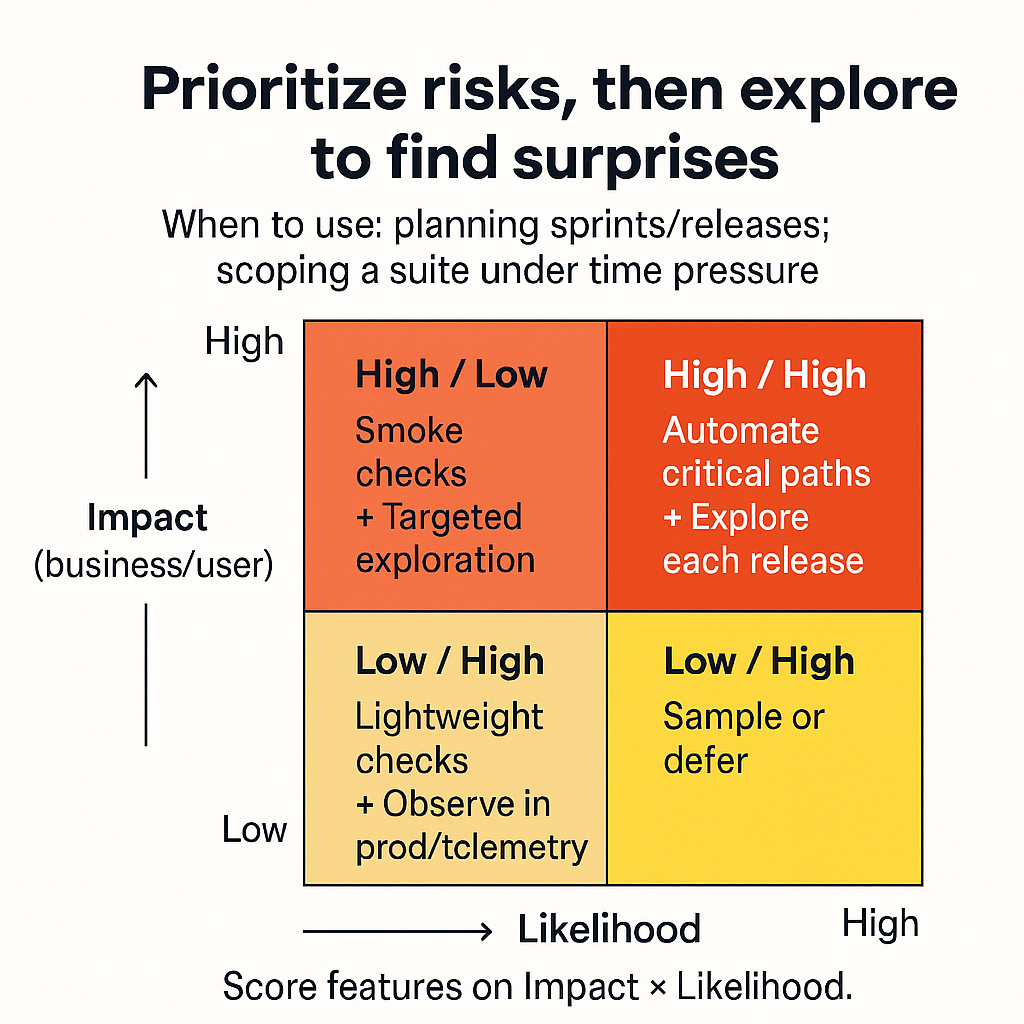Essential test design techniques for web apps
Want broader coverage with fewer tests?
These test design techniques help you create a smallest set of most effective tests.
This short guide covers boundary value analysis (BVA), equivalence partitioning (EP), risk-based prioritization, and model/state-transition testing.
You’ll learn when to use each technique, how to design the cases, and the minimal set that gives maximum signal.
Why test design techniques matter
Without structure, testing devolves into guesswork and redundancy. Design techniques give you a repeatable way to select high-value tests and avoid wasted effort.
What good test design delivers
- Eliminates redundancy using equivalence partitioning (EP)
- Catches edge bugs early with boundary value analysis (BVA)
- Focuses where it hurts via risk-based prioritization
- Covers complex flows using model- and state-transition testing
- Improves maintenance by organizing tests around models and risks, not pages
Use boundary & equivalence to minimize cases
When to use: Any input validation (forms, APIs, ranges, enums, formats).
How to design
- Identify input domains (range, set, format).
- Create partitions (valid + invalid).
- Pick one representative per partition (EP).
- Add BVA around each limit: just below, at, just above.
Minimal set example (age: 18–65 inclusive)
| Partition | Representative |
|---|---|
| valid (in-range) | 25 |
| valid (in-range) | 45 |
| valid (in-range) | 60 |
| invalid (< 18) | 17 |
| invalid (> 65) | 66 |
BVA targets: 17, 18, 65, 66
Tip: one mid-range value per valid partition is usually enough. Add more only if the code handles subranges differently.
Decision table (small, real example)
Discount applies when loyalty = gold and cart ≥ 100.
| Loyalty | Cart ≥ 100 | Expect |
|---|---|---|
| bronze | false | no discount |
| bronze | true | no discount |
| gold | false | no discount |
| gold | true | discount applied |
If rules × inputs explode, consider pairwise generation or MBT to keep the table tractable.
Prioritize risks, then explore to find surprises
When to use: Planning sprints/releases; scoping a suite under time pressure.
How to design
- Score features on Impact (business/user) × Likelihood (defect/complexity/change).
- Test high-impact/high-likelihood first; high-impact/low-likelihood next.
- Allocate exploratory charters to the highest-risk zones.
Quick 2×2
- High/High → automate critical paths + explore each release
- High/Low → smoke checks + targeted exploration
- Low/High → lightweight checks, observe in prod/telemetry
- Low/Low → sample or defer
Exploratory session charter (template)
- Area: Payments → promo codes
- Start with: expired code, special characters, rapid apply/remove
- Risks: rounding, concurrency, caching
- Timebox: 45 minutes
- Capture: notes, defects, screenshots, data used
Error-guessing checklist (starter)
- empty/huge inputs, whitespace, special characters
- copy/paste, different keyboard layouts, IME input
- rapid submit/double-click/back/refresh sequences
- timeouts, slow network, offline/restore
- concurrency: two tabs/users editing the same entity

Prioritizing risks
Model workflows with state transitions & BDD
When to use: Multi-step flows, role-based behavior, approvals, wizards.
How to design
- List states and allowed transitions (a sketch or bullets is enough).
- Cover all valid transitions at least once; include invalid transitions as negative tests.
- Use 0-switch/1-switch coverage: single transitions and adjacent transition pairs.
Example transitions (account recovery)
- Valid:
Start → RequestToken → EmailSent → ResetForm → Success - Invalid:
Start → ResetForm(no token) → expect a clear error
BDD scenario (executable specification)
Feature: Password reset
Scenario: Valid token enables password reset
Given a user requested a reset token
And the token is valid and not expired
When the user sets a new password that meets complexity
Then the user can sign in with the new password
User story → tests (traceability mini-map)
- Extract happy path, alternate paths, negative paths
- Link each scenario to acceptance criteria
- Map tests → story IDs for coverage reporting
Implementation tips
-
Start each feature with EP + BVA for inputs—keep it tiny and repeatable.
-
Re-score risks each sprint; prune or elevate tests based on change and incident data.
-
Schedule exploratory charters for top-risk areas every release.
-
Automate from models: generate cases from state charts/decision tables where feasible.
-
Track four signals:
- defect yield (by technique)
- redundancy removed (tests deleted/merged)
- flake rate (before/after design cleanup)
- requirements coverage (stories ↔ tests)
Summary
- Strategic efficiency: choose tests that add unique value, not volume.
- EP + BVA: cover representative inputs and edges with minimal cases.
- Risk + exploration: spend time where failures matter and surprises hide.
- Models & states: make complex flows testable and maintainable.
- Traceability: turn user stories and acceptance criteria into executable checks.
Skip manual test case creation. Wopee.io maps your app, applies user story-based test generation, explores high-risk flows, and generates coverage in minutes.
Test better. Ship faster.
Tip: Read more about how to apply test design techniques when you generate tests with Wopee.io.
